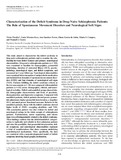Mostrar el registro sencillo del ítem
Characterization of the deficit syndrome in drug-naive schizophrenia patients: the role of spontaneous movement disorders and neurological soft signs
| dc.creator | Peralta Martín, Víctor | es_ES |
| dc.creator | Moreno-Izco, Lucía | es_ES |
| dc.creator | Sánchez Torres, Ana María | es_ES |
| dc.creator | García de Jalón, Elena | es_ES |
| dc.creator | Campos, María S. | es_ES |
| dc.creator | Cuesta, Manuel J. | es_ES |
| dc.date.accessioned | 2024-01-22T14:41:29Z | |
| dc.date.available | 2024-01-22T14:41:29Z | |
| dc.date.issued | 2014 | |
| dc.identifier.citation | Peralta, V., Moreno-Izco, L., Sanchez-Torres, A., García de Jalón, E., Campos, M. S., Cuesta, M. J. (2014) Characterization of the deficit syndrome in drug-naive schizophrenia patients: the role of spontaneous movement disorders and neurological soft signs. Schizophrenia Bulletin, 40(1), 214-224 | en |
| dc.identifier.issn | 0586-7614 | |
| dc.identifier.uri | https://hdl.handle.net/2454/47116 | |
| dc.description.abstract | This study aimed to characterize the deficit syndrome in drug-naive schizophrenia patients and to examine the relationship between deficit features and primary neurological abnormalities. Drug-naive schizophrenia patients (n = 102) were examined at baseline for demographics, premorbid functioning, duration of untreated illness (DUI), psychopathology, neurological signs, and deficit symptoms, and reassessed at 1-year follow-up. Neurological abnormalities were examined before inception of antipsychotic medication and included four domains of spontaneous movement disorders (SMD) and four domains of neurological soft signs (NSS). Patients fulfilling the deficit syndrome criteria at the two assessments (n = 20) were compared with nondeficit patients (n = 82) across demographic, clinical, and neurological variables. Deficit and nondeficit groups showed similar demographic characteristics and levels of psychotic, disorganization, and depressive symptoms. Compared with nondeficit patients, deficit patients showed poorer premorbid adjustment, higher premorbid deterioration, a lengthier DUI, and much poorer functional outcome. Relative to the nondeficit patients, those with the deficit syndrome showed higher levels of SMD—excepting akathisia—and NSS. This association pattern was also evident for deficit and neurological ratings in the whole sample of schizophrenia patients. Parkinsonism, motor sequencing, and release signs were all independently related to the deficit syndrome. These findings confirm that the deficit/nondeficit categorization is replicable and reliable in first-admission patients and raise the possibility that premorbid deterioration, deficit symptoms, and neurological abnormalities represent a triad of manifestations that share common underlying neurobiological mechanisms. More specifically, the data are consistent with a neurodevelopmental model of deficit symptoms involving basal ganglia dysfunction. | en |
| dc.description.sponsorship | Ministerio de Educación y Ciencia (SAF2008-05674-C03-02); Departamento de Salud del Gobierno de Navarra (946-2005, 55-2007); Comissionat per a Universitats i Recerca del DIUE (2009SGR827). | es_ES |
| dc.format.mimetype | application/pdf | en |
| dc.format.mimetype | application/msword | en |
| dc.language.iso | eng | en |
| dc.publisher | Oxford University Press | en |
| dc.relation.ispartof | Schizophrenia Bulletin 40(1), 2014, 214–224 | en |
| dc.rights | © The Author 2012. Published by Oxford University Press on behalf of the Maryland Psychiatric Research Center. All rights reserved. For permissions, please email: journals.permissions@oup.com | en |
| dc.subject | Deficit schizophrenia | en |
| dc.subject | Drug-naive | en |
| dc.subject | Neurological signs | en |
| dc.subject | Outcome | en |
| dc.subject | Symptom remission | en |
| dc.subject | Basal ganglia | en |
| dc.title | Characterization of the deficit syndrome in drug-naive schizophrenia patients: the role of spontaneous movement disorders and neurological soft signs | en |
| dc.type | Artículo / Artikulua | es |
| dc.type | info:eu-repo/semantics/article | en |
| dc.date.updated | 2024-01-22T13:52:19Z | |
| dc.contributor.department | Ciencias de la Salud | es_ES |
| dc.contributor.department | Osasun Zientziak | eu |
| dc.rights.accessRights | Acceso abierto / Sarbide irekia | es |
| dc.rights.accessRights | info:eu-repo/semantics/openAccess | en |
| dc.identifier.doi | https://doi.org/10.1093/schbul/sbs152 | |
| dc.relation.projectID | info:eu-repo/grantAgreement/MICINN//SAF2008-05674-C03-02/ES/ | en |
| dc.relation.projectID | info:eu-repo/grantAgreement/Gobierno de Navarra/// | en |
| dc.relation.publisherversion | https://doi.org/10.1093/schbul/sbs152 | |
| dc.type.version | Versión publicada / Argitaratu den bertsioa | es |
| dc.type.version | info:eu-repo/semantics/publishedVersion | en |


